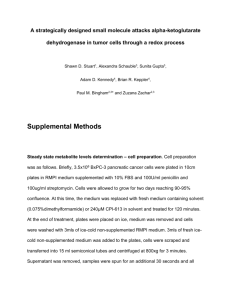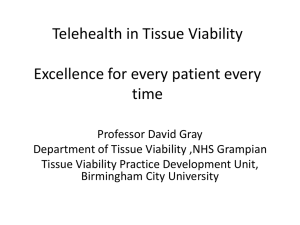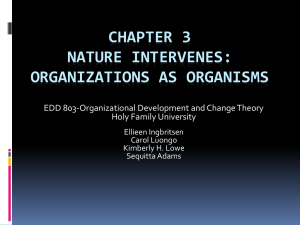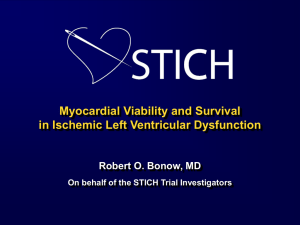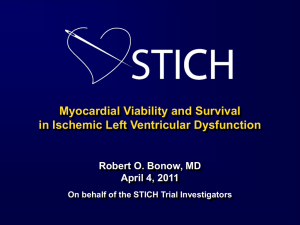Non-taxonomic biochemical tools for enhancing
advertisement
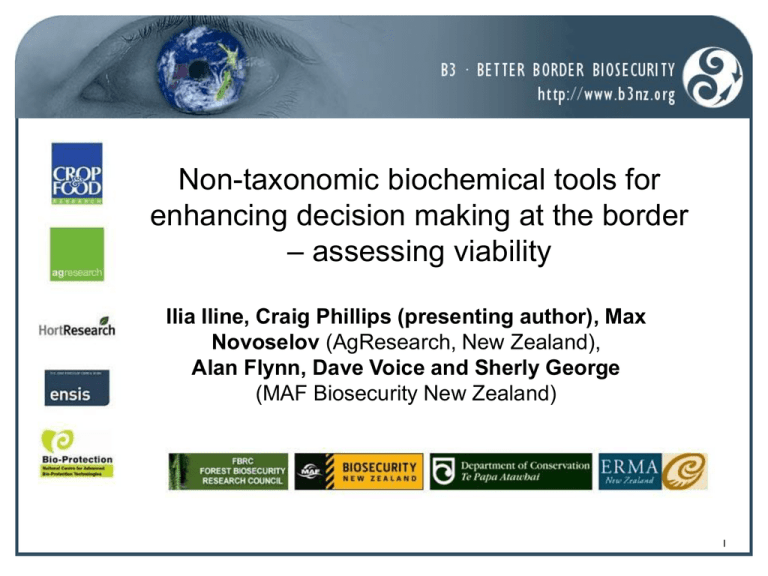
Non-taxonomic biochemical tools for enhancing decision making at the border – assessing viability Ilia Iline, Craig Phillips (presenting author), Max Novoselov (AgResearch, New Zealand), Alan Flynn, Dave Voice and Sherly George (MAF Biosecurity New Zealand) 1 Abstract • • • • • • • Non-taxonomic biochemical tools for enhancing decision making at the border Ilia Iline1, Craig Phillips1,2, Max Novoselov1, Alan Flynn3, Dave Voice4 and Sherly George3 1AgResearch, PB 4749, Christchurch 8140, NZ; and B3 (www.b3nz.org) 2Presenting author (craig.phillips@agresearch.co.nz) 3MAF Biosecurity New Zealand, PO Box 2095, Auckland, NZ 4MAF Biosecurity New Zealand, PO Box 24, Lincoln, NZ In addition to the daunting task of making taxonomic identifications of organisms that are intercepted at the border, regulatory authorities must also evaluate other characteristics of intercepted organisms such as their viability. When the intercepted organisms are sessile (e.g. eggs, pupae, scale insects) the challenge of rapidly and objectively assessing viability is significant, and the costs of incorrectly interpreting viability can be high. For example, if regulated scale insects associated with a consignment of imported produce were incorrectly assessed as being alive, the consignment may be unnecessarily rejected and either destroyed, fumigated or returned to the exporter. Alternatively, if the scale insects were incorrectly assessed as being dead, they could be allowed to cross the border into a new region or country, thus risking the establishment of a new pest. Viability assessments of sessile organisms are generally made using morphological criteria that demand high levels of user-experience to obtain reliable results. Moreover, morphological observations are often difficult to quantify or otherwise record in an objective manner, and this can cause problems when border authorities need to defend their viability assessments. This presentation describes a series of rapid, sensitive, inexpensive, simple-to-use biochemical tests that have been developed primarily for use by border authorities to make viability assessments of sessile organisms. The tests are also proving useful in other applications such as validating the efficacy of treatments that have been applied to consignments prior to export. The tests perform well across a diverse range of arthropods, and give easily interpreted, contrasting colour reactions depending on the viability of the organism; these can readily be quantified using a spectrophotometer or by measuring pixel values. The biochemical data have also shown that the physical appearance of sessile organisms can sometimes be misleading with respect to their viability. This work illustrates how relatively small research projects can help to increase the speed, reliability, objectivity, transparency, defensibility and overall efficiency of border biosecurity processes. 2 Quarantine inspections at the border lymantriid eggs & larvae on imported used car • Border authorities often detect organisms in or on imported goods & conveyances • (In NZ) infested items are held at border while MAFBNZ evaluates risks posed by the intercepted organisms 3 Quarantine inspections at the border • Strong commercial imperative not to slow trade – Many imports (e.g. fresh produce) are perishable – MAFBNZ assesses risks within 1 working day • Detection of high risk organisms can mean imported items must be (re-)treated, destroyed, or returned to the exporter – Major financial implications pentatomid eggs on imported fresh beans 4 Evaluating risk • First two questions asked 1. Is the organism alive? 2. What species is it? • Most realise that answering #2 can be difficult or impossible • Less well recognised that answering #1 is also often problematic 5 Insect eggs are often detected on imported fruit and vegetables Nitidulidae & Lonchaeidae Drosophilidae 1mm 6 Insect eggs are often detected on imported fruit and vegetables Blattodea Coccinellidae(?) 1mm 7 Assessing viability - rearing • Rearing / hatching is an obvious possibility, but involves – – – – Unacceptably long waiting periods Significant labour costs Specialist facilities, including containment labs Detailed biological knowledge 8 Assessing viability using morphological criteria • Scoring morphological criteria has been the most practical & frequently used method, but – Demands high levels of experience & expertise to obtain reliable results – Results difficult to quantify & defend – Morphology can be misleading Apparently dessicated weevil eggs that subsequently hatched 9 The challenge for research • Develop a viability assessment method that is – Fast – Objective – Easy to use – Inexpensive – Quantifiable & defensible – Sensitive enough for very small organisms • The marker used must degrade quickly after death – Too slow = false positive • Insensitive to presence of host plant material – Risk of false positives 10 A biochemical approach • The main idea – Many biomolecules (e.g. metabolic enzymes) should decline in concentration after the death of an organism – Develop a biochemical stain that indicates high (alive) or low (dead) concentrations of certain biomolecules 11 Results to date • A very straightforward test – Crush the organism in the stain – Wait for 3 – 7 minutes at room temperature – Look for a staining reaction • Several different staining systems have been developed • Some differences in suitability to different applications – E.g. differences in sensitivity, & in post-death degradation rate 12 Test results are quantifiable • Colour response can be quantified using a spectrophotometer, or a digital camera + image analysis software Aspidiotus nerii (oleander scale) 13 Tests can be conducted in tubes or on slides Hemiberlesia rapax (greedy scale) Aspidiotus nerii (oleander scale) 14 Evaluating the validity of biochemical test results • Alive versus heat inactivated • Treated versus untreated – Hydrogen cyanide, methyl bromide, phosphine, cool storage • Biochemical c.f. morphological c.f. rearing • To date, 9142 evaluations conducted on invertebrates spanning 18 Orders, 41 Families, 62 species and all insect life stages • Minimal test responses to host plant material of apple, kiwifruit, nectarine, orange, potato & rock melon – But positive responses to fungi associated with rotting plant material 15 MAFBNZ currently assessing suitability of test for its application • Begin using biochemical test alongside current morphological assessments to gain confidence and ensure results are robust • Implement quality control systems • Aim to have use of the test accredited (IANZ 17025) Even relatively small research projects can help to increase the overall efficiency of border biosecurity processes 16 Future steps & challenges • Publication • Overcoming technical limitations to preparing tiny organisms for testing (handling, crushing, staining) • Development and production of a test kit • Commercialisation versus open-source – currently protected by 2 provisional patents • Other applications (e.g. meeting export pre-clearance requirements, testing efficacy of treatments, maintenance of cultures) • Uptake by overseas quarantine authorities • Lots of ideas for additional diagnostic tests… 17 Acknowledgements Thanks to Mark McNeill, Nicola Richards, Gill Worth (AgResearch, Lincoln), and Lalith Kumarasinghe, Barney Stephenson, Kelly McAlpine and Rory Morrison (MAFBNZ) for assistance with various aspects The work was funded by B3 and MAFBNZ 18
